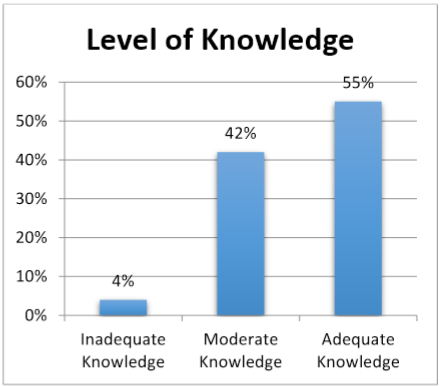“A Study to Assess the Level of Knowledge, Attitude, and Practice of Standard Safety Precautions among Staff Nurses in Kheda and Anand District”
Main Article Content
Abstract
Introduction
The invasion and growth of microorganisms those are not ordinarily present in the body, such as bacteria, viruses, and parasites. An infection may be subclinical and exhibit no symptoms, or it may be clinically evident and exhibit symptoms. An infection may move through the blood or lymphatic vessels to become systemic or it may stay localised (body wide). Infections are not thought to be caused by microbes that exist naturally in the body.
Background of the study
No of whether a patient has a suspected or proven infection, Standard Precautions are the minimal infection prevention procedures that must be followed in any place where medical care is provided. These procedures are intended to safeguard DHCP as well as stop it from infecting patients. Standard safety measures are designed to lower the danger of spreading blood-borne and other infections from both known and unknown sources. These are the fundamental measures of infection control that must be taken, at the very least, when caring for all patients.
Objectives of the study were
1) To assess the Knowledge of Standard Safety Precautions among Staff Nurses in Kheda and Anand District.
2) To assess the level of Attitude of Standard Safety Precautions among Staff Nurses in Kheda and Anand District.
3) To assess the level of Practice of Standard Safety Precautions among Staff Nurses in Kheda and Anand District.
4) To find out association between knowledge score with selected demographic variables among staff nurses in Kheda and Anand District.
Major findings and results of the study
The age distribution of the sample is as follows: sample 35 (50.07%) belongs to the 20–30 age group, sample 19 (27.05%) to the 31–40 age group, sample 09 (13%) to the 41–50 age group, and sample 6 (08.70%) to the 51–60 age group.
70 samples, 52 (75.04%) of the nurses were female, and 17 (24.06%) were male.
Regarding the Educational Qualification of nurses out of 70 samples, 02(2.9%) was ANM, 11(15.09%) was GNM, 55(79.07%) was B.Sc. Nursing, 1(1.4%) was M.Sc. Nursing.
Regarding the Years of Experience of nurses out of 70 samples, 49(71%) was <5 Years, 51(21.07%) was 5-10 Years and 05(07.2%) was >10 Years.
Regarding the Family Monthly Income of nurses out of 70 samples, 0(0%) was < 5000 Rupees, 34(49.03%) was 5000-10000 and 35(50.07%) was >1000 Rupees
Regarding the Exposure/training in infection control practices of nurses out of 70 samples, 68(98.06%) said yes and 1(1.4%) said No.
According to knowledge regarding Standard Safety Precautions where 03(04%) had Inadequate knowledge 29(42%) had Moderate knowledge, 38(55%) had Adequate Knowledge.
According to Attitude regarding Standard Safety Precautions where 06(09%) had Unfavourable Attitude 11 (16%) had Moderate Attitude, 53(77%) had Favourable Attitude.
According to practice on Standard Safety Precautions were found based on the practice questionnaire the nurses. Only 77.00 % nurses were found Favourable Attitude. 16.00% nurses with moderate favourable attitude and 9% nurses with unfavourable attitude.
Conclusion:
Conclusion of this research findings are as follows:
The majority of nurses has adequate knowledge and practice regarding Standard Safety Precautions. Only 4 % nurses was found that they do not follow proper Standard Safety Precautions. The study result evidence that almost school children’s have appropriate practice regarding all the aspect of Standard Safety Precautions only few sample were found not to follow practice properly.
The present study was conducted among nurses working in hospital at Nadiad and Anand city in Gujarat. It can be concluded that the percentage of Standard Safety Precautions in terms of knowledge, attitude and practices among primary school children was found to be satisfactory. Majority of nurses seem wear whole personal protective equipment, recap the used needle after injection, washes hands after taking off the gloves filtered water, wears gloves when comes in contact with blood. Standard Safety Precautions cannot be ignored. It should be followed by every nurse in the hospital. Proper training, knowledge and guidance in the hospital can increase the awareness and importance of Standard Safety Precautions among nurses through coordinated education measures by clinical instructor. Based on our current research finding we believe that the educational authorities and higher authority in the country can develop and adopt policies and guidelines that will make way to have adequate access to resources, items and opportunities to maintain Standard Safety Precautions in the hospital. Hospital should provide Standard Safety Precautions education to nurses, to ensure that all nurses learn how to use infection control practices used to prevent transmission of diseases that can be acquired by contact with blood, body fluids, non-intact skin (including rashes), and mucous membranes.
Article Details
References
Charles Patrick Davis [Internet].2021[updated 2021 March 29; Available from: https://www.rxlist.com/infection/definition.htm
NCI's Dictionary [Internet]. Microorganism. Available from: https://www.cancer.gov/publications/dictionaries/cancer-terms/def/microorganism
Sikora A, Zahra F. Nosocomial Infections. [Updated 2022 Jul 4]. In: StatPearls [Internet]. Treasure Island (FL): StatPearls Publishing; 2022 Jan-. Available from:
Society M. Microbes and disease | Microbes and the human body [Internet]. Microbiologysociety.org. 2022 [cited 29 July 2022]. Available from:
Standard precautions in health care [Internet]. Who.int. 2007 [cited 29 July 2022]. Available from: https://www.who.int/docs/default-source/documents/health-topics/standard-precautions-in-health-care.pdf
Standard precautions in health care [Internet]. Who.int. 2022 [cited 29 July 2022]. Available from: https://www.who.int/publications/m/item/standard-precautions-in-health-care
Critical Care - ICU: Safety [Internet]. Saskatoonhealthregion.ca. 2022 [cited 29 July 2022]. Available from: https://www.saskatoonhealthregion.ca/locations_services/Services/CriticalCare-ICU/Pages/Safety.aspx
Kermode M, Jolley D, Langkham B, Thomas MS, Holmes W, Gifford SM. Compliance with Universal/Standard Precautions among health care workers in rural north India. American journal of infection control. 2005 Feb 1;33(1):27-33.
Abuduxike G, Vaizoglu SA, Asut O, Cali S. An assessment of the knowledge, attitude, and practice toward standard precautions among health workers from a hospital in northern cyprus. Safety and health at work. 2021 Mar 1;12(1):66-73.

